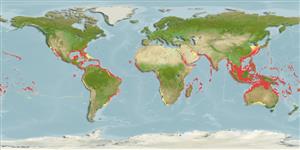Cephalopoda |
Oegopsida |
Onychoteuthidae
Environment: milieu / climate zone / djupintervall / distribution range
Ekologi
Pelagiska; djupintervall 1 - 200 m (Ref. 110525). Subtropical; 35°N - 36°S, 180°W - 180°E (Ref. 97142)
Indo-Pacific, Atlantic Ocean and the Mediterranean. Tropical to subtropical.
Length at first maturity / Size / Weight / Age
Könsmognad: Lm ? range ? - ? cm Max length : 10.0 cm ML hane/ej könsbestämd; (Ref. 97142)
Cosmopolitan circumglobal distribution, throughout tropical and subtropical/warm temperate oceans. Paralarvae and juveniles live near and at the surface, often in association with Sargassum sp. weed. Preyed upon by squid, Sthenoteuthis oualaniensis, and by yellowfin and bigeye tunas, and undoubtedly by many other epipelagic fishes and pelagic birds (Ref. 97142).
Life cycle and mating behavior
Könsmognad | Reproduktion | Lek | Eggs | Fecundity | Larvae
Members of the class Cephalopoda are gonochoric. Male and female adults usually die shortly after spawning and brooding, respectively. Mating behavior: Males perform various displays to attract potential females for copulation. During copulation, male grasp the female and inserts the hectocotylus into the female's mantle cavity where fertilization usually occurs. Life cycle: Embryos hatch into planktonic stage and live for some time before they grow larger and take up a benthic existence as adults.
Turgeon, D.D., J.F. Quinn Jr., A.E. Bogan, E.V. Coan, F.G. Hochberg, W.G. Lyons, P.M. Mikkelsen, R.J. Neves, C.F.E. Roper, G. Rosenberg, B. Roth, A. Scheltema, F.G. Thompson, M. Vecchione and J.D. Willams 1998 Common and scientific names of aquatic invertebrates from the United States and Canada: Mollusks, 2nd ed. American Fisheries Society (Special publication 26), Bethesda, Maryland. 526 p. (Ref. 1667)
IUCN Red List Status
(Ref. 130435: Version 2025-1)
CITES status (Ref. 108899)
Not Evaluated
Not Evaluated
Threat to humans
Human uses
| FishSource |
Verktyg
Ytterligare information
Population dynamicsTillväxtMax. ages / sizesLength-weight rel.Length-length rel.Length-frequenciesMass conversionAbundans PhysiologySyreförbrukning
Human RelatedStamps, coins, misc.
Internet-källor
Estimates based on models
Fishing Vulnerability
Low vulnerability (10 of 100).
